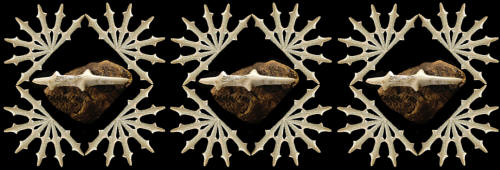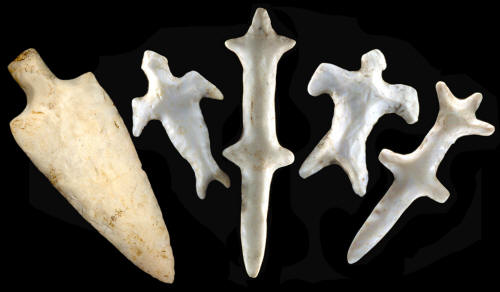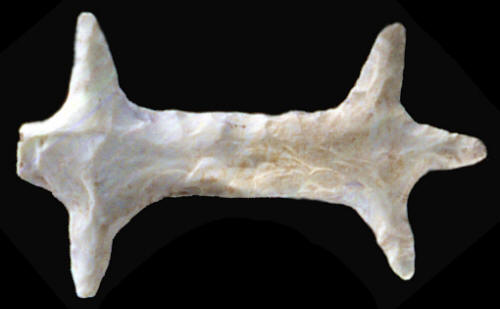|
|
|
The manufacturing process is fairly simple. Chert lizards were made from either fresh flakes or from already finished points. If they were made from already finished points, the chosen point may have had some significance to the individual who reshaped it. The initial form was made by percussion & pressure flaking. The final finishing work was done by grinding and polishing the surface until, in some cases, almost all flake scars were removed. |
|
|
It's interesting to see how the lizard theme is used in different cultures. Lizards have been described in mythic tales and illustrated in many different forms. Their physical bodies have also had special uses. In Pomo myths, lizard is described as a creator of humans or in a conversation with coyote, he offers his hands as a design for human hands, etc. The Carib of the West Indies were quite superstitious about travel at sea----"While at sea they ate no crabs or lizards and drank no water, for fear of not being able to reach land." Of course, lizards have been widely used as a food source for protein. The skins of lizards are also used for various items, even as jewelry by the Chaco of central South America---"It has become fashionable among the acculturated Indians to wear rings made of segments of the tail skin of lizards." In central Australia, the Arunta medicine men must receive a certain type of lizard energy into their bodies that gives them "great suctorial powers" to heal the sick. |
|
|
|
|
Polished chert lizards where not items used in a utilitarian function such as food processing or as a tool to shape wood or bone. They show no use wear. Lizard effigies represent an iconographic theme that suggests a connection between a group of people over a period of time. These were not items made by individual flights of fancy. Polished lizards were used within a society or religious concept that involved many people with the same idea, whatever that idea was. |
|
|
|
|
Polished lizards are easy to identify with their four legs, long tail and a head. We know how they were made, the areas where they were used and a reasonable idea of how old they are. But beyond that, they will always be mysterious objects. Their purpose may have been simple or if they relate in part to a concept similar to New Guinea je stones, they could have many different uses and meanings. In either case they must have been important to the people who once owned them. |
|
|
"REFERENCES"
1912, Hodge, Frederick Webb,
"Problematical Objects," Handbook of American Indians North of Mexico,
pp. 307-308. |
|



